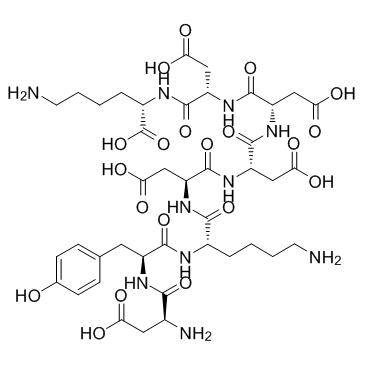98849-88-8
| Name | L-Lysine, L-α-aspartyl-L-tyrosyl-L-lysyl-L-α-aspartyl-L-α-aspartyl-L-α-aspartyl-L-α-aspartyl |
|---|---|
| Synonyms |
FLAG Peptide
FLAG EPITOPE PEPTIDE FLAG tag Peptide ASP-TYR-LYS-ASP-ASP-ASP-ASP-LYS |
| Description | FLAG peptide is an eight amino acids peptide (Asp-Tyr-Lys-Asp-Asp-Asp-Asp-Lys) with an enterokinase-cleavage site; designed for antibody-mediated identification and purification of recombinant proteins. |
|---|---|
| Related Catalog | |
| In Vitro | Fusion protein technology has become an important tool for solving numerous problems linked to recombinant protein production. The properties of the additional tag facilitate identification and provide a one-step purification procedure of the fusion protein by passing cell extracts or supernatants through columns of an appropriate matrix. FLAG peptide allows elution under non-denaturing conditions. Several antibodies against FLAG peptide have been developed. One antibody, M1, binds the peptide in the presence of bivalent metal cations, preferably Ca2+. Elution is effected by chelating agents. Another strategy is competitive elution with excess of free FLAGe peptide. Antibodies M2 and M5 are applied in this procedure[1]. The Flag-tag is first described as a calcium-dependent epitope of a monoclonal antibody. It is a highly acidic octapeptide which can be N-terminally fused to the protein of interest. As a very hydrophilic peptide the Flag–tag has a high surface probability. Flag-fusion proteins can be captured by an immunoaffinity column in the presence of Ca2+ and eluted byEDTA at low concentrations, neutral pH and thus, nearly physiological conditions[2]. |
| References |
| Molecular Formula | C41H60N10O20 |
|---|---|
| Molecular Weight | 1012.97000 |
| Exact Mass | 1012.40000 |
| PSA | 525.79000 |
| Storage condition | -20°C |
